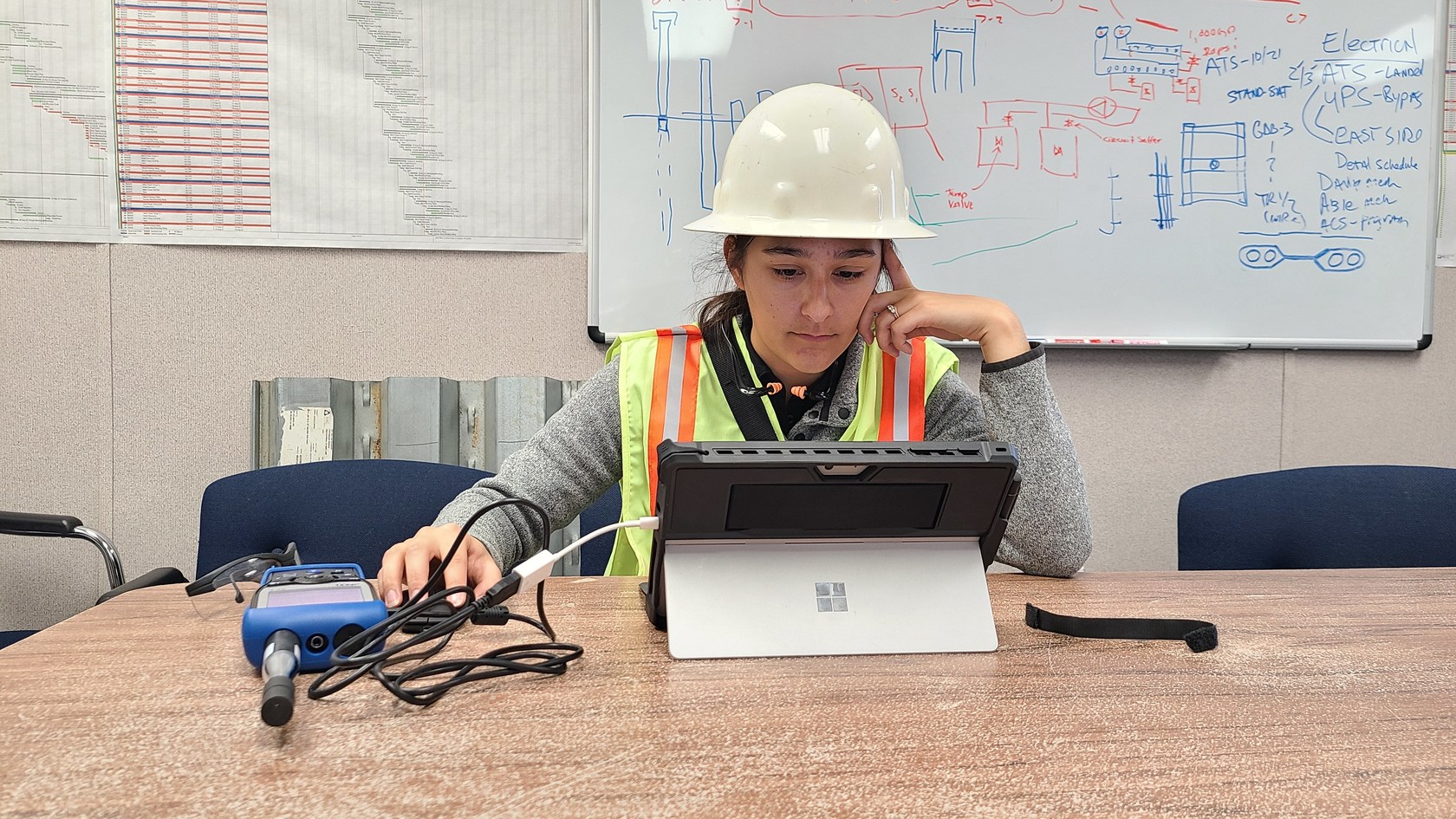News & Insights
16 types of engineering careers at Salas O’Brien
Are you a student interested in becoming an engineer but are not sure what area to specialize in? This article provides an overview of different types of engineering careers available at Salas O’Brien.

Types of engineering careers at Salas O’Brien
Every engineering project we undertake tells a story of collaboration, discovery, and sustainable design. The people who write these stories—our engineers—are as diverse as the projects they work on. We employ and mentor:
Mechanical Engineers
Mechanical engineers design and oversee large equipment in a building, including heating, ventilation, and air-conditioning systems.
Education path: Pursue a bachelor’s degree in mechanical engineering. This undergraduate program usually takes four years to complete and provides a comprehensive understanding of core mechanical engineering principles and practices.
Sample projects our team has designed: One Bennet Park, McDonald’s Corporate Headquarters Building, St. Lawrence Centre for the Arts
Electrical Engineers
In the construction field, electrical engineers are responsible for designing, developing, testing, and supervising electrical equipment deployment, including lighting and power systems within buildings.
Education path: Pursue a bachelor’s degree in electrical engineering. This undergraduate program usually takes four years to complete and provides a comprehensive understanding of core electrical engineering principles and practices.
Sample projects our team has designed: West Access Plaza, Coca-Cola store in Disney Springs, SunTrax Autonomous Vehicle Facility
Plumbing Engineers
Plumbing engineers design and implement systems for water supply and drainage in a building, including related specialty systems like medical gases in labs or hospitals. Their work is integral to ensure that the water supply and waste disposal systems are operating efficiently and effectively.
Education path: Pursue a bachelor’s degree in civil or mechanical engineering or a closely related field. Some colleges and vocational schools offer courses specifically in plumbing engineering as part of their civil or mechanical engineering programs.
Sample projects our team has designed: Hard Rock Stadium Upgrades, Pharmaceutical Packaging Facility, Metropolitan Washington Airports Authority (MWAA)
Fire Protection Engineers
Fire protection engineers specialize in designing fire suppression systems, ensuring compliance with fire safety codes and standards, providing risk management, and providing fire modeling and simulation.
Education path: Pursue a bachelor’s degree in fire science or related engineering field. Many professionals get their start as professional or volunteer firefighters while pursuing a four-year degree.
Sample projects our team has designed: Launch Complex 41 at Cape Canaveral, City of Gainesville Fire Station No. 1, Fortune 15 Telecommunications Company
Structural Engineers
Structural engineers analyze, design, plan, and research structural components and systems to achieve design goals and ensure the safety and comfort of users or occupants. They have expertise in foundations, building science, building materials, seismic issues, testing methodologies, and structural forensics.
Education path: Pursue a bachelor’s degree in civil engineering with a focus or concentration in structural engineering. Some universities may offer specific structural engineering programs as well. The undergraduate program usually takes four years to complete and covers core engineering subjects, including mechanics, materials science, structural analysis, and design.
Sample projects our team has designed: Park Union Bridge, Harbor Plaza Residences, Merck Research Labs

Building Envelope Engineers
A specialty of structural engineering, these professionals design and protect the essential barrier that separates indoor spaces from outside elements.
Education path: Pursue a bachelor’s degree in civil engineering, architectural engineering, or a related field. Some universities may offer specialized programs or concentrations in building envelope engineering or building science. During the undergraduate program, students will study various subjects, including structural mechanics, building materials, heat transfer, thermodynamics, and building systems.
Sample projects our team has designed: Westin Building Envelope Condition Assessment, Governor’s Office of Emergency Services Roofing, NIH Facility Assessment Services
Civil Engineers
Civil engineers design, plan, and oversee everything from the ground down in a construction project. This includes civil site development like utilities (water and wastewater), managing stormwater, constructing pavements, dealing with geotechnical challenges, and protecting coastal/shoreline areas.
Education path: Pursue a bachelor of engineering (B.E.) or a bachelor of science (B.S.) degree in civil engineering. This undergraduate program usually takes four years to complete and provides a comprehensive understanding of core civil engineering principles and practices.
Sample projects our team has designed: University of Notre Dame Campus Crossroads Expansion, 69kv Substation Relocation, Launch Complex 41 at Cape Canaveral
Technology Designers
A specialty of electrical engineering, these professionals focus on the design and integration of technology systems within buildings. This could range from telecommunications and data networks to advanced audio, video, and control systems.
Education path: Pursue a bachelor’s degree in electrical engineering, physics, audio/video production, or computer engineering. Many technology designers get their start in related jobs in AV or IT at the universities where they study or through volunteer work or internship programs.
Sample projects our team has designed: Harvard Klarman Hall, Salesforce Tower, Broadway Theatre Live Entertainment Venue, Darrell K Royal Texas Memorial Stadium

Acoustic Engineers
These professionals deal with how sound interacts within spaces, noise and vibration control, sound isolation, and environmental noise.
Education path: Pursue a bachelor’s degree in acoustics, architecture, physics, or mechanical engineering. The path for acoustic engineers will focus on understanding how noise and vibration interact with the built environment.
Sample projects our team has designed: YouTube Theater, Climate Pledge Arena, Denver Art Museum
Physical Security Engineers
A specialty of electrical engineering, these professionals design and implement systems to protect buildings and their occupants. This may involve planning for the use of CCTV, access control, alarm systems, and other security measures.
Education path: Pursue a bachelor’s degree in a computer science field, electrical engineering, physics, electronics, or security-related major. Many professionals in this field have military experience.
Sample projects our team has designed: Hospital Redevelopment, Rogers Centre Major Renovation, Union West New Apartment Complex
Lighting Designers
A specialty of electrical engineering, these professionals design the lighting layout for buildings to achieve both functional and aesthetic goals. This discipline blends the technical aspects of lighting systems, including energy efficiency and control, with light quality and artistic vision.
Education path: Pursue a bachelor’s degree in electrical engineering or lighting design. Many professionals in this field get their start volunteering in arts and entertainment programs.
Sample projects our team has designed: Ed Mirvish Theatre Harry Potter Transformation, Meridian Arts Centre, Stanton Territorial Hospital, Brooklyn Tabernacle Historical Renovation
Commissioning Engineers
These professionals ensure that all systems of a building are designed, installed, tested, and maintained according to the operational requirements of the owner or final client. They play a vital role in the construction process to validate that a building’s complex systems meet the design intent and the owner’s operational needs.
Education path: Pursue a bachelor’s degree in mechanical engineering, energy engineering, or electrical engineering.
Sample projects our team has designed: Washington Monument Commissioning, City Hyde Park, National Synchrotron Light Source II
Renewable Energy Engineers
This discipline bridges mechanical and electrical engineering and involves using renewable energy sources (such as wind, solar, and geothermal) to meet energy needs. Renewable energy engineers work on the design, testing, and implementation of energy systems or devices.
Education path: Pursue a bachelor’s degree in environmental engineering or a related field, such as civil, chemical, energy, or electrical engineering.
Sample projects our team has designed: District Energy System, Geothermal Campus System, Edwards Air Force Base Photovoltaic & Battery Storage Program
Process Engineers
Process engineers design, implement, automate, and optimize industrial processes. This includes helping clients improve efficiency and reach sustainability goals.
Education path: Pursue a bachelor’s degree in industrial or mechanical engineering. The path for process engineers will focus on simulation modeling, database systems, quality assurance, logistics and supply chain management, operations research, and facilities planning.
Sample projects our team has designed: International Beverage Manufacturer, Metal Separator Plant, Labatt Brewing Company
Building Science Engineers
Building science engineers analyze and control the physical phenomena affecting buildings, such as heat transfer, moisture, light and solar radiation, wind, weather, and seismic activity.
Education path: Pursue a bachelor’s degree in civil engineering with a focus or concentration in structural engineering. Some universities may offer specific structural engineering programs as well. The undergraduate program usually takes four years to complete and covers core engineering subjects, including mechanics, materials science, structural analysis, and design.
Sample projects our team has designed: 712 West Peachtree, UC Berkeley Soda Hall Roofing & Waterproofing, Five-Story Medical Building
Environmental Engineers
Environmental engineers use engineering principles to develop solutions to environmental problems. They are involved in efforts to decarbonize energy usage, improve recycling, minimize waste, and protect water and air.
Education path: Pursue a bachelor’s degree in environmental engineering, environmental science, or a related field. Some universities offer specific environmental engineering programs while others may have environmental engineering tracks within civil engineering programs.
Sample projects our team has designed: Occoquan Bay National Wildlife Refuge, Pacific Gas and Electric Company (PG&E), Decontamination at Joint Munitions Command, Zoo Atlanta

Advice on educational paths for engineering careers
Once you begin your career as an engineer, you may want to seek a license as a Professional Engineer. The PE designation can distinguish you in the field and create growth.
It’s important to know as you select your career path that to apply for a license as a Professional Engineer requires a bachelor’s degree from an engineering program accredited by the Accreditation Board for Engineering and Technology (ABET) in the US and by the Canadian Engineering Accreditation Board (CEAB) in Canada.
There are many strong technical institutes and trade schools which offer outstanding training programs in engineering providing entry into the field. Some professionals begin their careers with a vocational degree and later complete their bachelor’s degree at an accredited school to pursue licensure. Others continue to become experts in their field without licensure.
We highly encourage students to participate in internships or co-op programs with architectural, construction, or engineering firms. Practical experience is crucial for gaining hands-on knowledge and can make your application stand out when pursuing your first job.

Salas O’Brien needs more than engineers to be successful
In addition to engineers, there are many other types of talented professionals that help us serve clients at Salas O’Brien.
Project managers: These individuals oversee and coordinate engineering projects, ensuring they are completed on time, within budget, and meet the client’s requirements.
Architects: Salas O’Brien has architects that serve specific markets with high sustainability values.
Specialty consultants: We have many professionals who provide specialized expertise and strategy within different industries, such as automation and robotics consultants for manufacturing and theatre consultants for performing arts.
BIM specialists: Building information modeling (BIM) professionals work closely with engineers to create detailed models and technical drawings using modeling software.
Human resources: HR personnel handle recruitment, employee onboarding, training, and other personnel-related tasks.
Marketing and communications: Marketing and communications professionals promote our services and assist the team in acquiring new projects.
Finance and accounting: Finance and accounting professionals handle financial matters, including budgeting, invoicing, payroll, and financial reporting.
Information technology: IT professionals manage the firm’s databases, computer systems, networks, and software, ensuring smooth functioning of the inner workings of the firm.
You can have impact with a career in engineering at Salas O’Brien
Salas O’Brien is in the business of shaping futures. We firmly believe that engineering isn’t simply about buildings; it’s about the people who benefit from them, the communities that thrive around them, and the new generations inspired to create them.
You can make a difference in the way people work, travel, discover, play, eat, heal, and live. You can be part of solving the most challenging issues that face our world.
Whether you’re passionate about sustainability, cutting-edge technology, the nuances of building sciences, or the intricacies of electrical engineering, there’s a place for you here.
For more detailed information on what it’s like to work at Salas O’Brien or to view our current open positions, check out our careers page.
For media inquiries on this article, reach out to Stacy Lake.

Want the pdf version? Get the guide
Are you a student interested in becoming an engineer but are not sure what area to specialize in? This quick quide provides an overview of the different types of engineering careers and the educational paths to get there.
Get the guide
John De Rosa
A seasoned strategist, John De Rosa leads HR integration and programs for Salas O’Brien. Joining the firm during a transformative period, John has been instrumental in installing robust enterprise programs and streamlining internal systems to sustain Salas O’Brien’s fast-paced growth. A strong leader and team builder, John serves as Associate Vice President, Director HR Integration & Programs at Salas O’Brien. Contact him at [email protected].
